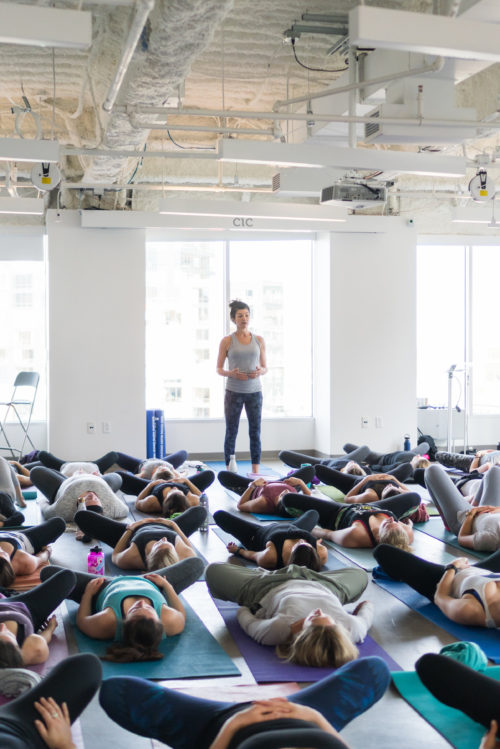
When I started out as a teacher, I was taught alignment. I was taught the shapes of the poses and the cues to help students make these shapes with their bodies. Things like, “Stack your knee over your heel” and “roll your shoulder back” became part of my vernacular. But if one of my students asked me, “Why is that important?” I wouldn’t have a good answer.
The other issue I heard all the time was the refrain, “I’m not flexible enough to do yoga!” I heard this from students as well as people who knew I was a yoga teacher and still hear it all the time. In fact, when I watch students in class, I can tell from the movements they make that they’re fueled with the idea of “being more flexible.” They push hard in Downward Dog, they double bind even though their shoulders are not ready for it, they push their shin forward to line up with the front edge of the mat even though it takes them out of the pose. I get it. It’s in part fueled by misinformed thinking that “being flexible is better than being tight” and fueled by students who attend classes where the emphasis is on going deep in poses as well as elaborate movements and variations that most bodies just can attain. In many ways, it’s also fueled by confusion over how to bring anatomy into class in a way that’s understandable. It’s also related to the issue that there’s a host of teachers out there who would love to know more about anatomy and are looking for ways to learn.
Over the years, I’ve slowly but surely made anatomy the cornerstone of my teaching. As teachers, we’re making choices all the time about what we’ll emphasize: spirit, anatomy, alignment, breath and a host of all the other options available to us. When we focus on anatomy though, we give our students useable information they can use both on and off the mat. We also can make a huge impact by speaking directly to the body. Sometimes it’s hard to speak to spirit and have it translate well because spiritual themes can mean different things to different people. But when you say something like, “Root your back heel” or “Press your palms flat” you cut through all the noise and speak directly to the student’s body.
Further, when you understand the “why” behind the cues, the “why” behind the alignment, you understand the anatomy and you can share that with your class. You can speak to the reason why the back foot should be slightly turned in during Warrior 2 (that hip is internally rotating) and you can help people understand the difference between an “open” and “closed” hip ( something people say all the time but don’t always understand). You can help students recognize how contracting the rhomboids in the middle of the back can in turn help them stretch their pectoral muscles and how this can counteract all the hunching they do all day. This is where you can share information that helps them off the mat as well as on the mat. This is where your teaching starts to take on a broader impact than just in the moments where people are practicing.
The more you understand anatomy and its application to yoga, you can allay those concerns that “being flexible” is the goal and help people understand the reasons why having healthy tension in their muscles is necessary to give the body integrity in its shape. You can share why the body is so smart that even as you push like crazy off your arms in Downward Dog because you want stretchy hamstrings, muscle receptors will sense the risk to your hamstrings and actually begin to create contractions to prevent your muscle from rupturing at its origin. You can share with students that the idea of any movement practice is healthy range of motion not super flexibility and that to get there, we need a healthy balance of both stretch and strength.
Teaching yoga comes from a desire to share what you love. That’s always at the cornerstone for teachers. I happen to love anatomy so for me, it was a natural thing to make sharing anatomy the main focus of my practice. But maybe you’re out there and you’d love to understand more about anatomy but aren’t sure how to do it. It seems like such a broad subject, you don’t know where to start. I also hear quite often that despite graduating from a 200 hour training, teachers don’t have a good grasp on anatomy. So, there’s a gap in understanding there and one that I try to fill with all the content that I produce. I recently wrote a blog post that outlines an approach to tackling the subject of anatomy. You can read it here.Â
I also produced a free series of yoga videos that break down many of the fundamental postures and give their alignment and the anatomy. You can download the guide to my LEARN YOGA CHALLENGE here.Â
Remember that even if your passion is to focus on another aspect of yoga outside of anatomy, having a solid understanding of anatomy is critical to anyone teaching yoga. It will broaden your understanding of your own body, help you watch your students with a more keen level of awareness and give you the knowledge you need to provide really meaningful cues.
Thanks for reading and feel free to leave your comments and thoughts on the post. I’d love to hear what you think.Â

I want to grow up to be like you! It must feel amazing to be in your class. Excited to get into that anatomy book of yours!
Deby, thanks so much for your nice comment! I do hope we have a chance to meet up one day. I sent out that manual and you should definitely get it this week!